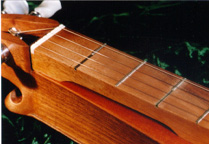Using FlexiFrets®
So, what can we do with these new gizmos? I dreamed FlexiFrets® (U.S. Patent 5,952,593) up because I saw so many dulcimer players struggling with the question, "Whether to install Extra Frets?"
The dulcimer is a diatonically fretted instrument, unique in American music. Yet we often want to play something with sharps or flats we just can't get to easily. As we populate the diatonic fretboard with more and more "extra frets" we risk losing contact with the charm of the modal music so natural to the dulcimer. So, I reasoned, why not have a dulcimer that can be diatonic yet flexible--one with temporary frets just when we need them! FlexiFrets! Now you can have the frets you want from time to time, without having to live with them for rest of your life.
Also, consider those partial-width frets. Using them, you can have FlexiFrets under some strings but not others. Put a quarter-width fret in at the 1-1/2 fret under the middle string, for instance. Dave Murray has created a very nice tool for charting the chords that can be reached using various FlexiFrets. It is available on his Mountain Dulcimer Fretboard page.
Here are some other ideas:
- Choosing the First Register Kit, you can now have any half-fret in the first octave (and a little beyond, to 10-1/2).
- With the First Register Kit, you can play almost any key from almost any tuning. For instance (all the following examples are from conversations with Lucy Sollogub, a wonderful dulcimist and teacher, of Norwood, MA), using a tuning of CGC
To play in D major:- install FlexiFrets at 3-1/2 and 7-1/2
- Capo at the first fret
To play in E flat:
- install FlexiFrets at 4-1/2 and 8-1/2
- Capo at the 1-1/2 fret
To play in E:
- install FlexiFrets at 3-1/2, 4-1/2, 6-1/2, 7-1/2 and 8-1/2
- Capo at the second fret
- Or slide in quarter-width frets under the third string at every half-fret, giving you a chromatic bass line while your melody remains modal.
- With the Chromatic Kit, install all FlexiFrets and play chromatically into the second octave, all the way up the fretboard. Remove the FlexiFrets to return to modal play
- With the Configurable Fretboard Kit:
 Take a close look at this diagram. It shows how to set up your fretboard in the seven modes, using the Configurable Fretboard Kit. You can now play in any mode starting from the open string--in any tuning you choose--by shifting the whole diatonic pattern up or down the fretboard. You no longer have to use a capo (and accept the accompanying key change) to play in a different mode.
Take a close look at this diagram. It shows how to set up your fretboard in the seven modes, using the Configurable Fretboard Kit. You can now play in any mode starting from the open string--in any tuning you choose--by shifting the whole diatonic pattern up or down the fretboard. You no longer have to use a capo (and accept the accompanying key change) to play in a different mode.
- Likewise, play in any key without a capo or changing mode, by shifting the diatonic pattern up and down the fretboard.
- Install FlexiFrets at each semi-tone and play chromatically
- If you need a shorter scale length for a piece, install a full-width FlexiFret at the 0-1/2 or 1st fret, capo behind it, and shift the diatonic fret pattern down. Now you have a fretboard which is shorter.
- The Scheitholt had frets under one or two strings, leaving the other strings as drones. With the Configurable Fretboard Kit, you could re-incarnate the Scheitholt on your Appalachian Dulcimer.
- And, finally, with the Configurable Fretboard Kit, re-fretting your instrument--a major expense for a conventional stringed instrument--will now be a nominal charge.
- Worn out FlexiFrets can be replaced for a nominal charge. Just install one of your spares and keep playing, while you send the worn-out fret back to Bear Meadow. We will copy it and send you a new one for a nominal charge.

